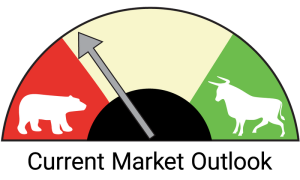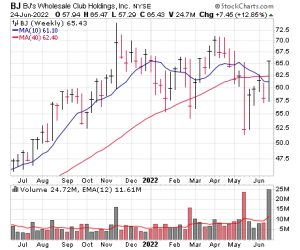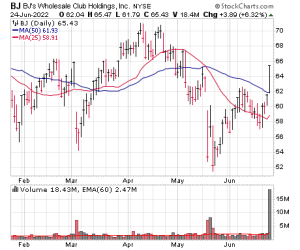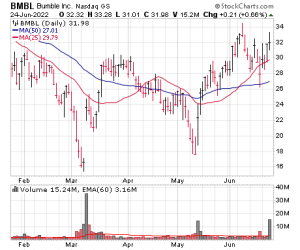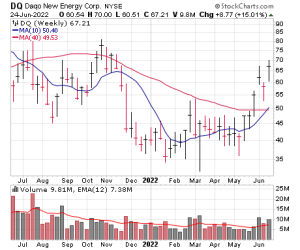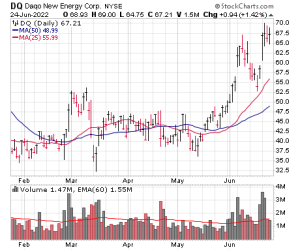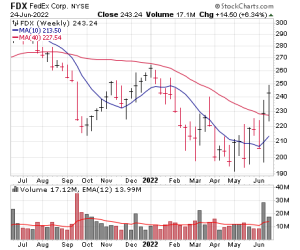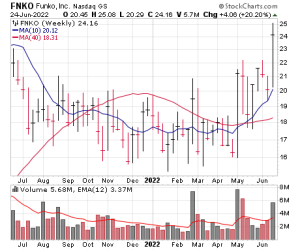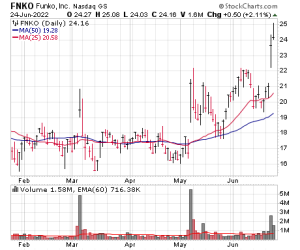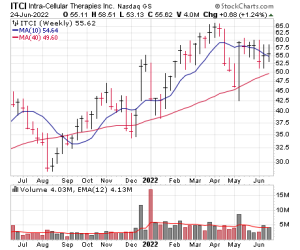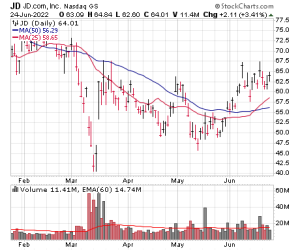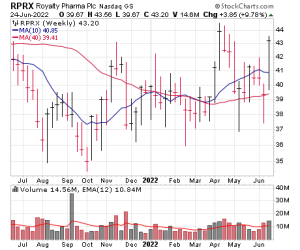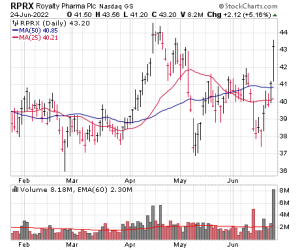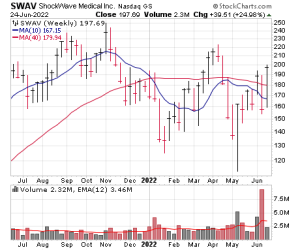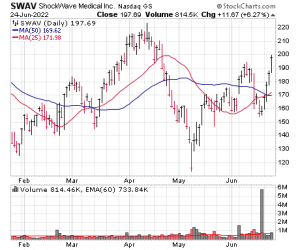Note: Due to the celebration of Independence Day next week, the next issue will be delivered Tuesday, July 5.
After two brutal weeks for the indexes, the market staged a very nice snapback last week, and this comes after some decent resilience in many growth names during the June mini-crash. But the real question is can the market build on it: We’ve seen a handful of nice baby steps for the market this year, but each time the sellers reappear quickly and smack everything lower. Overall it’s best to remain mostly defensive until the buyers show they’ve conclusively taken control from the bears, which will take more time.
On a positive note, this week’s list has many names either showing some outsized accumulation of late or are forming solid bottoming areas. Our Top Pick is one that’s had a couple of false starts this year but looks ready to run if the market can get going.
Cabot Top Ten Trader Issue: June 27, 2022
DOWNLOAD ISSUE PDFWanted: Follow Through
After two brutal weeks for the indexes, the market staged a very nice snapback last week, and this comes after some decent resilience in many growth names during the June mini-crash—in fact, for the first time in months, the Nasdaq and growth funds are actually acting a bit better than the rest of the market, which is usually a constructive occurrence. That’s a small positive character change, as is the fact that it’s becoming easier to find stocks that have etched higher lows in recent weeks and months. But the real question is can the market build on it: We’ve seen a handful of nice baby steps for the market this year, but each time the sellers reappear quickly and smack everything lower. Based on what we see, we are nudging up our Market Monitor to a level 3, but overall it’s best to remain mostly defensive until the buyers show they’ve conclusively taken control from the bears, which will take more time.
On a positive note, this week’s list is an example why we are hiking our Market Monitor by a notch, with all of the names either showing some outsized accumulation of late or are forming solid bottoming areas. Our Top Pick is Royalty Pharma (RPRX), which has had a couple of false starts but looks like it could be changing character.
| Stock Name | Price | Buy Range | Loss Limit |
| Biomarin Pharm (BMRN) | 85 | 83-86 | 74-76 |
| BJ Wholesale (BJ) | 65 | 62-64.5 | 55-57 |
| Bumble (BMBL) | 31 | 29-31 | 24.5-25.5 |
| Daqo New Energy (DQ) | 72 | 66.5-70 | 56-58 |
| FedEx (FDX) | 241 | 233-238 | 211-214 |
| Funko (FNKO) | 24 | 23-24 | 20-20.5 |
| Intra-Cellular Therapies (ITCI) | 58 | 56-58.5 | 48-50 |
| JD.com (JD) | 66 | 63-66 | 54-56 |
| Royalty Pharma (RPRX) ★ TOP PICK ★ | 43 | 41.5-43.5 | 37-38 |
| Shockwave Medical (SWAV) | 198 | 185-195 | 157-162 |
Stock 1
Biomarin Pharm (BMRN)
| Price | Buy Range | Loss Limit |
| 85 | 83-86 | 74-76 |
Why the Strength
In the underserved market for rare, genetically-driven diseases, treatments are typically hard to find or may not exist. But that provides an opportunity for BioMarin, which develops and commercializes innovative biopharmaceutical therapies for a range of “orphan” diseases that afflict fewer than 200,000 people. BioMarin boasts a deep research and development pipeline focused on therapies that address several key areas. Its leading pipeline candidate is called BMN 270, a treatment for severe hemophilia, and it recently met all primary and secondary efficacy endpoints in a Phase III trial. Biomarin has been on a regulatory roll lately, as just last week its achondroplasia treatment Voxzogo, the only approved therapy for children whose growth plates aren’t closed, was granted approval in Japan (a reason for the strength) after receiving U.S. and E.U. approval late last year. Additionally, BioMarin’s gene therapy Roctavian, for treating severe hemophilia A, just got the backing of the European Medicines Agency for conditional approval in the E.U. But this is not a development stage outfit, as the company has seven commercially approved therapies that address diverse ailments including hereditary angioedema, hyperoxaluria and Duchenne muscular dystrophy (DMD). On the financial front, Q1 revenue of $519 million was 7% higher from a year ago, while per-share earnings of 63 cents were off slightly but blew past estimates by 33 cents. This puts BioMarin on track to deliver on its prediction for double-digit revenue growth and overall profitability in 2022, driven by estimated Voxzogo sales of around $112 million (a 10% increase from prior estimates). But the real prize should come in 2023, with analysts seeing the drug’s continuing rollout and potential new approvals and label expansions driving sales up nearly 30% and sending earnings much higher.
Technical Analysis
BMRN hit a multi-year peak around 130 in July 2020, but took a sharp tumble from there and were dead in the water for the better part of two years—shares even nosed to new multi-year lows just a couple of weeks ago! But the damage on that dip was minimal, and with biotech stocks acting better, BMRN may be changing character, with a couple of strong-volume buying weeks that have actually taken the stock above some near-term resistance. If you want in, nibbling here or on minor weakness makes sense.
| Market Cap | $16.1B | EPS $ Annual (Dec) | |
| Forward P/E | 130 | FY 2020 | 1.63 |
| Current P/E | 66 | FY 2021 | 1.33 |
| Annual Revenue | $1.88B | FY 2022e | 0.67 |
| Profit Margin | 20.3% | FY 2023e | 2.18 |
| Qtrly Rev | Qtrly Rev Growth | Qtrly EPS | Qtrly EPS Growth | |
| ($M) | (vs. yr-ago-qtr) | ($) | (vs.yr-ago-qtr) | |
| Latest qtr | 519 | 7% | 0.54 | -5% |
| One qtr ago | 450 | -1% | 0.04 | -81% |
| Two qtrs ago | 409 | -14% | 0.18 | -64% |
| Three qtrs ago | 502 | 17% | 0.53 | 66% |
Weekly Chart | Daily Chart |
Stock 2
BJ Wholesale (BJ)
| Price | Buy Range | Loss Limit |
| 65 | 62-64.5 | 55-57 |
Why the Strength
Retail sellers that are in the deep discount area of the market, be them regular stores (like a Dollar Tree or Ollie’s Bargain Outlet) or subscription-based (like Costco), are thriving as shoppers look to cushion themselves from inflation’s impact. BJ’s Wholesale operates a membership-only warehouse club with over 200 locations across 17 states, mainly along the East Coast. BJ’s membership count grew to 6.5 million in the first quarter (up 5% from a year ago) as consumers were drawn to the company’s bargain prices for a variety of goods that come in lower than its biggest rivals. Revenue was 16% higher in Q1, including a 4% increase in comparable club sales, while membership fee income jumped 12%. The company emphasized that while physical store growth remains a priority (the company plans to open 11 warehouses this year and 10 next year, resulting in ~5% annual store growth), management is also expanding its digital business, which it views as a key competitive advantage—digital sales grew 26% in Q1 and are up over 400% in the last three years. The firm reported “robust growth” across all its digital channels, including buy online, pickup in store (BOPIC) and curbside, and it just became the first warehouse club to partner with DoorDash to facilitate “frictionless shopping.” BJ is also increasing its fresh food offerings to customers, recently acquiring a perishable food distribution network from Burris Logistics to further this initiative. Further, BJ is committed to shareholder returns and repurchased $36 million worth of shares in Q1 with plans to continue buybacks “opportunistically.” Don’t get us wrong, BJs isn’t going to be a hot growth stock or see earnings double in a year, but the top brass believes growth can pick up and come in faster than pre-pandemic days, which should keep buyers interested.
Technical Analysis
BJ had a smooth ride last year, cranking ahead from the low 40s in the first part of the year to the 70 area after earnings in November. That was the top (along with the market), and shares have etched a big double-bottom base since then, with a dip into the mid 50s in both January and March, and then a shakeout after earnings in May. But the last five weeks have seen a character change for BJ, with shares pushing back above its moving averages last Friday. Dips of a couple of points would be tempting.
| Market Cap | $8.85B | EPS $ Annual (Jan) | |
| Forward P/E | 20 | FY 2021 | 3.09 |
| Current P/E | 18 | FY 2022 | 3.25 |
| Annual Revenue | $17.3B | FY 2023e | 3.31 |
| Profit Margin | 2.6% | FY 2024e | 3.69 |
| Qtrly Rev | Qtrly Rev Growth | Qtrly EPS | Qtrly EPS Growth | |
| ($M) | (vs. yr-ago-qtr) | ($) | (vs.yr-ago-qtr) | |
| Latest qtr | 4.5 | 16% | 0.87 | 21% |
| One qtr ago | 4.36 | 10% | 0.80 | 14% |
| Two qtrs ago | 4.26 | 14% | 0.91 | -1% |
| Three qtrs ago | 4.18 | 6% | 0.82 | 6% |
Weekly Chart | Daily Chart |
Stock 3
Bumble (BMBL)
| Price | Buy Range | Loss Limit |
| 31 | 29-31 | 24.5-25.5 |
Why the Strength
Tinder (owned by Match.com) is still the top dog in the U.S. online dating sector, but Wall Street is enamored of Bumble, which looks like the next big thing in the industry—the company has gained market share every year since 2017, is currently second in number of users (the distance between it and #3 continues to widen, too) and has the highest net promotor score (a market research tool that infers customer loyalty) in the group. The reason it’s catching on is because of some industry-wide trends—some shift away the hookup culture in the wake of the pandemic—but mainly because Bumble itself has some unique qualities, the main one being a woman-first positioning: Women have to make the first move when it comes to initiating a chat, giving them more power (and also taking the pressure of shy men, too). There’s also (by most estimates) fewer bots on the site and less ghosting, thanks to a policy that chats must be responded to within a day or else they vanish (which also ups engagement and urgency, so to speak), and on the marketing side of things, the firm is likely to launch student bundles as well as consumables/virtual items and has a “BFF” (best friend forever) strain for people just looking to make some friends. The company also owns Badoo, which is big internationally but is shrinking right now (lots of Ukraine and Russian cancellations for obvious reasons), but Bumble itself is three quarters of revenue and growing quickly (total revenues were up 24% in Q1, Bumble app revenue was up 38%). More important for Wall Street seems to be user growth, with subscribers up 31% from the prior year and with the top brass expecting the number of net new additions to the platform to pickup in Q2 and Q3. It’s a good story.
Technical Analysis
BMBL came public at the worst time (February 2021, near the nadir for glamour stocks) and crashed over the next 11 months, but there’s little doubt big investors are beginning to become interested—BMBL found gigantic volume support after earnings in March (a major clue) and had another huge buying spree after earnings in May. All in all, the stock has been building a low for a few months, and the last three weeks (while super volatile) look like a reasonable shelf after its May/June rally. If you want in, consider a small position here or on dips.
| Market Cap | $4.14B | EPS $ Annual (Dec) | |
| Forward P/E | 152 | FY 2020 | -1.29 |
| Current P/E | N/A | FY 2021 | -1.08 |
| Annual Revenue | $806M | FY 2022e | 0.21 |
| Profit Margin | 11.3% | FY 2023e | 0.39 |
| Qtrly Rev | Qtrly Rev Growth | Qtrly EPS | Qtrly EPS Growth | |
| ($M) | (vs. yr-ago-qtr) | ($) | (vs.yr-ago-qtr) | |
| Latest qtr | 211 | 24% | 0.13 | N/A |
| One qtr ago | 208 | 26% | -0.08 | N/A |
| Two qtrs ago | 201 | 24% | -0.06 | N/A |
| Three qtrs ago | 186 | 38% | -0.06 | N/A |
Weekly Chart | Daily Chart |
Stock 4
Daqo New Energy (DQ)
| Price | Buy Range | Loss Limit |
| 72 | 66.5-70 | 56-58 |
Why the Strength
With oil prices solidly north of $100 a barrel despite the recent retreat, companies that offer renewable energy technologies are unsurprisingly among the market’s hottest performers—and, interestingly, after years in the doghouse, many of those are from China. Daqo New Energy is a China-based manufacturer of solar energy materials, specializing in the production of polysilicon (also known as silicon metal) used mainly in photovoltaic systems, as well as silicon wafers. Polysilicon prices have remained stubbornly high in recent years, and in fact recently hit their highest level in a decade, boosted by strong demand from the solar industry. But Daqo’s high-purity polysilicon is not only in demand from the solar industry, but is also used in the manufacture of semiconductors. Earlier this year, Daqo announced that its subsidiary, Xinjian, was approved for a polysilicon project in Mongolia that will support both industries. More recently, Daqo signed an agreement to supply the material to China-based Zhonghuan Semiconductor for its solar wafer business. Daqo has been turning heads on the financial front, with Q1 revenue of $1.3 billion exploding 400% higher from a year ago in Q1. Per-share earnings of $6.99, meanwhile, flew past estimates by 70 cents. The firm’s polysilicon production volume grew 33% from the prior quarter in Q1, while sales of the product leapt by an astounding 240% sequentially, thanks to higher prices (cost controls also helped the bottom line). Looking ahead, the company expects to produce 5% more polysilicon in Q2 than in the previous quarter and guided for full-year production to increase 42%. Management also sees strong market demand and product pricing across the entire solar PV value chain going forward and plans to increase capacity. Analysts see the bottom line retrenching in 2023 due to a cooling in demand, but it’s likely that proves too pessimistic.
Technical Analysis
DQ had a spectacular post-pandemic run, mushrooming from just under 15 in early 2020 to 130 last February. The going since then has been decidedly less sanguine, however, as shares spent the next year sliding to 35, where a bottom was finally established in March. The last few months of bottom-building provided DQ with a launching pad for the recent move back up to 70 on excellent volume. Volatility is obviously extreme, so while the action is great, aim to start small on a shakeout if you want in.
| Market Cap | $4.95B | EPS $ Annual (Sep) | |
| Forward P/E | 3 | FY 2020 | 1.96 |
| Current P/E | 4 | FY 2021 | 9.89 |
| Annual Revenue | $2.70B | FY 2022e | 20.21 |
| Profit Margin | 41.9% | FY 2023e | 13.17 |
| Qtrly Rev | Qtrly Rev Growth | Qtrly EPS | Qtrly EPS Growth | |
| ($M) | (vs. yr-ago-qtr) | ($) | (vs.yr-ago-qtr) | |
| Latest qtr | 1280 | 400% | 6.99 | 524% |
| One qtr ago | 396 | 60% | 1.87 | 83% |
| Two qtrs ago | 586 | 367% | 3.84 | 999% |
| Three qtrs ago | 441 | 231% | 3.06 | 999% |
Weekly Chart | Daily Chart |
Stock 5
FedEx (FDX)
| Price | Buy Range | Loss Limit |
| 241 | 233-238 | 211-214 |
Why the Strength
While e-commerce sales have fallen post-pandemic, business-to-business delivery demand is recovering while shipping rates are strong. These factors are a big reason behind the strength of FedEx, along with some positive changes in response to an activist investor (more on that below). As for the numbers, the shipping giant reported a fiscal Q4 results last week, and they were just OK—sales rose 8% and earnings lifted a solid 37%, though both missed estimates by a decent amount. While Q4 volumes were lower across all segments compared to fiscal 2021, FedEx successfully implemented actions that drove double-digit yield improvement across the board with its Express segment composite yield per package up 20%, Ground up 11% and Freight yield per shipment up 28%. Still, the real news was in the guidance, with fiscal 2023 (through next May) likely to see something around $23.50 per share in earnings (up about 14% year on year), which was solidly above estimates despite the dark clouds hanging over the economy. Adding to the good vibes are many shareholder friendly actions, in part pushed by activist investor DE Shaw, who recently was granted a couple of new board seats—FedEx bought back $2.2 billion of stock in the past 12 months and sees $1.5 billion of buybacks in the next six months, while the dividend was recently hiked by more than 50% (1.9% current yield). Based partly on plans to improve fleet and facility efficiencies, analysts see 10%-ish growth annually going forward, which isn’t bad for a firm trading at 11 times trailing earnings. The firm will be hosting an Investor Day(s) starting on Tuesday of this week.
Technical Analysis
FDX hit an all-time high of 320 last June as the Covid-led e-commerce shipping boom reached its apex. The past year has seen the stock mostly trending lower, interspersed with a couple of bear market rallies (one between October and January and another in March) along the way. But shares did spend a couple of months building a solid bottom in the 190 to 200 area and now the stock has come alive on the shareholder moves and earnings. If you’re game, look for modest dips to enter.
| Market Cap | $63.0B | EPS $ Annual (May) | |
| Forward P/E | 11 | FY 2021 | 18.17 |
| Current P/E | 11 | FY 2022 | 20.61 |
| Annual Revenue | $93.5B | FY 2023e | 22.61 |
| Profit Margin | 5.6% | FY 2024e | 24.88 |
| Qtrly Rev | Qtrly Rev Growth | Qtrly EPS | Qtrly EPS Growth | |
| ($M) | (vs. yr-ago-qtr) | ($) | (vs.yr-ago-qtr) | |
| Latest qtr | 24.4 | 8% | 6.87 | 37% |
| One qtr ago | 23.6 | 10% | 4.59 | 32% |
| Two qtrs ago | 23.5 | 14% | 4.83 | 0% |
| Three qtrs ago | 22 | 14% | 4.37 | -10% |
Weekly Chart | Daily Chart |
Stock 6
Funko (FNKO)
| Price | Buy Range | Loss Limit |
| 24 | 23-24 | 20-20.5 |
Why the Strength
Figurine maker Funko is turning itself into a pop-culture powerhouse, recently adding high-end collectibles maker Mondo to its portfolio. Mondo makes premium-priced limited edition pop culture items focused on music and poster-art– it’s currently selling a 4-LP vinyl record set featuring the music from Rogue One: A Star Wars Story and a one-off poster for the 2015 movie Inside Out. Once a limited edition sells out, it’s never reprinted. The business should fit in nicely with Funko’s dominance in figurines with its distinct big-headed plastic toys of icons like Britney Spears to the characters from the new season of Stranger Things. Collectibles have always had a solid core group of enthusiasts, but the stay-at-home crowd during the pandemic supercharged the industry, embracing collecting and bidding up prices for everything from trading cards to NFTs – the blockchain based non-fungible tokens that are a new wave of digital collectibles. Funko started its own NFT “Digital Pop!” line last year, although its original business of four-inch-tall models remains as strong as ever. The company has more than 900 licensed brands, including Disney, the NBA and Seinfeld, with no license accounting for more than 6% of sales. Even as revenue has risen 30% since 2019, to $1.03 billion – and the latest quarter saw sales leap 63% year-over-year – there appears to be a lot of room for organic growth at the company: Three-fourths of sales are in the U.S., offering opportunities to capitalize on licenses from international favorites like the English Premier League, UFC and anime characters. For the current year, look for earnings to grow 34% to $1.90 a share, on sales of around $1.3 billion.
Technical Analysis
FNKO gapped higher last week on a ratings upgrade from J.P. Morgan, touching at a 52-week high at 25. Shares have been showing improvement for some time beforehand, consolidating in a year-long cup formation despite the horrid market environment, which was clearly a sign of resilience. The 26 to 29 area will likely offer some resistance, and besides, buying strength in the current environment has been tricky to say the least. Bottom line, if you want in, aim for weakness.
| Market Cap | $1.20B | EPS $ Annual (Dec) | |
| Forward P/E | 13 | FY 2020 | 0.37 |
| Current P/E | 16 | FY 2021 | 1.42 |
| Annual Revenue | $1.15B | FY 2022e | 1.90 |
| Profit Margin | 6.0% | FY 2023e | 2.14 |
| Qtrly Rev | Qtrly Rev Growth | Qtrly EPS | Qtrly EPS Growth | |
| ($M) | (vs. yr-ago-qtr) | ($) | (vs.yr-ago-qtr) | |
| Latest qtr | 308 | 63% | 0.34 | 42% |
| One qtr ago | 336 | 48% | 0.38 | 31% |
| Two qtrs ago | 268 | 40% | 0.39 | 26% |
| Three qtrs ago | 236 | 141% | 0.40 | N/A |
Weekly Chart | Daily Chart |
Stock 7
Intra-Cellular Therapies (ITCI)
| Price | Buy Range | Loss Limit |
| 58 | 56-58.5 | 48-50 |
Why the Strength
We’re usually not big on one-drug biotech firms, as any hint of competition or a raised eyebrow from regulators can cause the stock to tumble—but Intra-Cellular Therapies could be the exception, with its drug Caplyta looking like a huge blockbuster that will drive sales through the roof in the years ahead (and, who knows, possibly attract a suitor). To recap, Caplyta was approved for schizophrenia a couple of years ago, and the potential there is solid (2.4 million people have the disease) and sales grew nicely because of that. But it was the drug’s broad approval for Bipolar (approved for both I and II either with some other drugs or by itself) that is the real attraction—in fact, Caplyta is the only drug approved for Bipolar II in conjunction with other drugs, and its only competition as a monotherapy for Bipolar II is something originally launched back in 1997 that has drawbacks (Caplyta is one dose per day, doesn’t have to be taken with food, doesn’t have any weight gain effects and patients don’t need to gradually ramp up usage). There are some other potential indications down the road (Phase III testing is ongoing for Major Depressive Disorder, which is a giant market), but the Bipolar potential is what’s driving things today: Caplyta has all the makings of a blockbuster, with revenues leaping from $26 million in Q4 to $35 million in Q1 (new prescriptions jumped north of 60% during that time) and analysts see the top line totaling $223 million this year and $438 million next, both of which are probably going to be conservative. We like it.
Technical Analysis
ITCI is one of the few stocks out there that’s set up in a legitimate launching pad and could get going if the market can get out of its own way. The stock actually pushed higher earlier this year before finally giving way to the market’s downturn in April and early May—but, impressively, shares bounced back strongly after earnings and have traded rather tightly for a few weeks. If you want in, we’re OK with a nibble here, or just keep it on your watch list and look for an eventual breakout.
| Market Cap | $5.25B | EPS $ Annual (Dec) | |
| Forward P/E | N/A | FY 2020 | -3.23 |
| Current P/E | N/A | FY 2021 | -3.50 |
| Annual Revenue | $103M | FY 2022e | -2.97 |
| Profit Margin | N/A | FY 2023e | -1.25 |
| Qtrly Rev | Qtrly Rev Growth | Qtrly EPS | Qtrly EPS Growth | |
| ($M) | (vs. yr-ago-qtr) | ($) | (vs.yr-ago-qtr) | |
| Latest qtr | 35 | 120% | -0.78 | N/A |
| One qtr ago | 25.7 | 106% | -1.05 | N/A |
| Two qtrs ago | 22.2 | 201% | -0.95 | N/A |
| Three qtrs ago | 20.1 | 950% | -0.85 | N/A |
Weekly Chart | Daily Chart |
Stock 8
JD.com (JD)
| Price | Buy Range | Loss Limit |
| 66 | 63-66 | 54-56 |
Why the Strength
JD.com is one of China’s largest online retailers, as well as the country’s biggest Internet company by revenue, with offerings ranging from fresh food and apparel to electronics and cosmetics. With China’s two largest cities just emerging from a lengthy Covid-related shutdown, deliveries for discretionary retail goods (like PC devices and apparel) are expected to jump in the months ahead based on pent-up demand. While JD stands to benefit from this anticipated trend, it’s also planning a foray into on-demand food delivery in a market that should provide a significant new revenue stream for the company (a reason for the strength). Additionally, sentiment for JD was recently buoyed when China’s government announced new economic stability measures, along with relaxed regulatory measures for tech-oriented companies, which is a big reversal from the prior couple of years. Q1 results, reported in May, were hindered by lockdowns but still weren’t awful—revenue still surpassed expectations by rising 11% from a year ago while earnings rose 5%. By segment, retail sales rose 17% to $33 billion, while revenue from logistics climbed 22% to $4 billion, and a major Wall Street bank to maintain a “buy” rating on the stock and up its expectations for JD’s sales. Meanwhile last week, the company reported positive results from China’s “618” shopping season (which covers the first 18 days of June and is the nation’s second-largest consumer shopping event); JD said it sold $57 million in goods during the event, up 10% from last year, in another sign demand is just starting to ramp. Growth should accelerate from there as parts of the country re-open; analysts see things picking up in Q3 and see earnings up more than 50% in 2023.
Technical Analysis
JD slumped with the rest of China’s broad stock market, peaking at 108 in February 2021 and hitting a nadir slightly above 40 in this March of this year, where it and the entire sector found massive-volume support. The last 14 weeks have seen JD etch out a bottoming pattern, with a higher low (at 50) in May and a solid five-week rally that’s seen shares hold above their 50-day line. There’s plenty of overhead, of course, but we like the setup and think a nibble here could work.
| Market Cap | $99.6B | EPS $ Annual (Dec) | |
| Forward P/E | 36 | FY 2020 | 1.51 |
| Current P/E | 37 | FY 2021 | 1.67 |
| Annual Revenue | $154B | FY 2022e | 1.80 |
| Profit Margin | 1.7% | FY 2023e | 2.78 |
| Qtrly Rev | Qtrly Rev Growth | Qtrly EPS | Qtrly EPS Growth | |
| ($M) | (vs. yr-ago-qtr) | ($) | (vs.yr-ago-qtr) | |
| Latest qtr | 37.8 | 22% | 0.40 | 5% |
| One qtr ago | 43.4 | 26% | 0.35 | 52% |
| Two qtrs ago | 33.9 | 32% | 0.49 | -2% |
| Three qtrs ago | 39.3 | 38% | 0.45 | -10% |
Weekly Chart | Daily Chart |
Stock 9
Royalty Pharma (RPRX) ★ Top Pick
| Price | Buy Range | Loss Limit |
| 43 | 41.5-43.5 | 37-38 |
Why the Strength
Royalty Pharma is the largest buyer of pharmaceutical royalties, commanding about 60% of biotech’s royalty payments from a portfolio of about 45 approved and development-stage products including a dozen blockbuster ($1 billion or more in sales) therapies in the market place. The business is agnostic around type of therapy, modality and drug class – it’s focused on using its financial expertise and heft to help facilitate deals. Royalty Pharma acquires its royalties by buying out other royalty owners, providing capital to pay for early – or late-stage clinical testing and/or funding product launches. Pablo Legorreta founded the business in 1996 and still runs it, having guided the company to a 13% top line compounded annual growth rate over the last decade, to $2.6 billion revenue in 2021. The established management team probably gives Royalty Pharma greater access to partnerships in the industry, including with research institutions including Emory and New York universities and non-profits such as Massachusetts General Hospital and the Cystic Fibrosis Foundation. One key to the business is maintaining a steady flow of new royalty streams to push out expected income as long as it can. The company estimates 80% of its portfolio expected to be generating cash flow beyond 2030, up from 70% at its mid-2020 IPO. Right now, the top brass says it has stakes in six recent drug launches that outside analysts expect to be blockbusters by 2025. Legorreta is telling Wall Street it will grow top-line cash receipts faster than the S&P 500 and biotech peers over the next three years, generating $2.97 earnings per this year, nearly doubling 2021, with a current dividend yield of 1.8%.
Technical Analysis
We’ve written up RPRX a couple of times this year, but the market hasn’t let the stock get moving—but we think the third time could be the charm. Shares have effectively been range bound not just recently, but also since its mid 2020 IPO, but we see signs of improvement—the RP line (not shown) has been rising nicely this year; the three-week, big-volume buying spree in April bodes well; and the stock also saw solid accumulation last week as it etches a 10-week base. Nibbling on minor weakness is OK, or just keep it on your watch list.
| Market Cap | $26.0B | EPS $ Annual (Dec) | |
| Forward P/E | 15 | FY 2020 | 1.58 |
| Current P/E | 28 | FY 2021 | 1.49 |
| Annual Revenue | $2.28B | FY 2022e | 2.97 |
| Profit Margin | 9.3% | FY 2023e | 3.37 |
| Qtrly Rev | Qtrly Rev Growth | Qtrly EPS | Qtrly EPS Growth | |
| ($M) | (vs. yr-ago-qtr) | ($) | (vs.yr-ago-qtr) | |
| Latest qtr | 562 | -2% | 0.12 | -33% |
| One qtr ago | 576 | 1% | 0.10 | -64% |
| Two qtrs ago | 586 | 9% | 0.17 | -65% |
| Three qtrs ago | 555 | 9% | 1.08 | 108% |
Weekly Chart | Daily Chart |
Stock 10
Shockwave Medical (SWAV)
| Price | Buy Range | Loss Limit |
| 198 | 185-195 | 157-162 |
Why the Strength
Shockwave Medical is in the early stages of its growth wave, with new products that are becoming the standard of care for a major problem. The story revolves around calcified arteries (stemming from plaque buildup), which is obviously a growing issue as the population ages worldwide; calcium can resist expansion efforts (and thus balloons don’t work well), while atherectomies have a steep learning curve, can result in perforations and even artery blockages if the calcium that’s broken apart travels downstream. Instead, the industry is stampeding toward Shockwave’s intravascular lithotripsy offerings, which uses an old technique (sonic pressure waves used to break apart the calcium; it’s been used for kidney stones for decades) and applies it here, leading in far better results (one recent study showed Shockwave’s products outdoing stents and balloons everywhere from 30 days to two years later). Initial approval for peripheral arteries was met with great success, but it was the 2021 approval for coronary products (leading to a total addressable market of $8.5 billion) that led to the out-of-this-world numbers you see in the table below. And while growth rates could ease some, major upside looks to be in the bag: Shockwave just entered the U.K. and France late last year; Japan coronary sales should start around year-end; and, via a partner in Singapore, the company received approval for a handful of its periphery and arterial products in China. Analysts see sales and earnings exploding this year and then rising 31% and 47% (respectively) in 2023, but given the magnitude of the recent beats (this year’s earnings estimate has risen from $1.39 per share to $2.03 per share in the past three months), even those guesstimates should prove low. It’s a great growth story that should persist for years if management pulls the right levers.
Technical Analysis
Frankly, the “worst” part of SWAV’s chart is the action in 2020-2021—meaning shares had such a big run that you wonder if they’ll simply will need more time to rest before really getting going again. But SWAV certainly doesn’t act like it’s tired: The massive-volume shakeout-and-recovery week in May was the big clue, and the fact that the RP line is nearly in new high ground says a lot. Shares move around a ton, so we advise aiming for dips, keeping any new buys small and using a loose loss limit.
| Market Cap | $7.06B | EPS $ Annual (Dec) | |
| Forward P/E | 96 | FY 2020 | -1.99 |
| Current P/E | 242 | FY 2021 | -0.26 |
| Annual Revenue | $299M | FY 2022e | 2.06 |
| Profit Margin | 15.5% | FY 2023e | 3.02 |
| Qtrly Rev | Qtrly Rev Growth | Qtrly EPS | Qtrly EPS Growth | |
| ($M) | (vs. yr-ago-qtr) | ($) | (vs.yr-ago-qtr) | |
| Latest qtr | 93.6 | 194% | 0.39 | N/A |
| One qtr ago | 84.2 | 271% | 0.34 | N/A |
| Two qtrs ago | 65.2 | 233% | 0.05 | N/A |
| Three qtrs ago | 55.9 | 443% | -0.01 | N/A |
Weekly Chart | Daily Chart |
Previously Recommended Stocks
Below you’ll find Cabot Top Ten Trader recommended stocks. Those rated HOLD are stocks that traded within our suggested buy range within two weeks of appearing in the Top Ten and still look good; hold if you own them. Stocks rated WAIT have yet to dip into our suggested buy range … but can be bought if they do so within the next week.
Those stocks rated SELL should be sold if you own them; they will no longer be listed here. Finally, Stocks in the DROPPED category are those that failed to trade within our buy range within two weeks of our recommendation; that’s not a bad thing, we just never got the price we wanted. Please use this list to keep up with our latest thinking, and don’t hesitate to call or email us with any questions you may have. New recommendations each week are in bold.
| Date | Stock | Symbol | Top Pick | Original Buy Range | Price as of 6/27/2022 |
| HOLD | |||||
| 6/13/22 | Academy Sports | ASO | ★ | 32-34 | 38 |
| 6/6/22 | Alkermes | ALKS | 27.5-29 | 30 | |
| 6/21/22 | Argenx | ARGX | 345-355 | 374 | |
| 5/23/22 | Bumble | BMBL | 25.5-27.5 | 31 | |
| 5/16/22 | Celsius | CELH | 53-56 | 67 | |
| 6/21/22 | CrowdStrike | CRWD | 161-168 | 182 | |
| 5/10/21 | Devon Energy | DVN | ★ | 25-26.5 | 58 |
| 5/31/22 | Dollar Tree | DLTR | 155-161 | 157 | |
| 6/6/22 | Enphase Energy | ENPH | 197-205 | 206 | |
| 5/16/22 | Funko | FNKO | 18.8-19.8 | 24 | |
| 4/18/22 | Halozyme | HALO | 40.5-42 | 47 | |
| 6/21/22 | HealthEquity | HQY | 67-70 | 67 | |
| 5/16/22 | Intra-Cellular Therapies | ITCI | 54-57 | 58 | |
| 6/13/22 | Jabil | JBL | 55.5-57 | 55 | |
| 6/13/22 | Jinkosolar | JKS | 56-58.5 | 68 | |
| 5/23/22 | Nexstar Media | NXST | 173-178 | 167 | |
| 6/13/22 | Neurocrine Bio | NBIX | 89-92 | 100 | |
| 6/13/22 | Nordstrom’s | JWN | 23.5-25 | 25 | |
| 6/21/22 | Ollie’s Bargain Outlet | OLLI | 56-58.5 | 63 | |
| 6/21/22 | Pinduoduo | PDD | 59-62 | 65 | |
| 6/13/22 | Scorpio Tankers | STNG | 31-33 | 37 | |
| 6/21/22 | SolarEdge | SEDG | 270-285 | 299 | |
| 6/6/22 | Synopsis | SNPS | 317-326 | 312 | |
| 5/31/22 | Ulta Beauty | ULTA | 410-420 | 401 | |
| 5/31/22 | United Therapeutics | UTHR | ★ | 224-230 | 241 |
| WAIT | |||||
| 6/21/22 | Li Auto | LI | ★ | 33-35 | 39 |
| 6/21/22 | LPL Financial | LPLA | 196-200 | 192 | |
SELL RECOMMENDATIONS | |||||
| 5/31/22 | Alpha Metallurgical | AMR | 155-163 | 143 | |
| 5/23/22 | Civitas Resources | CIVI | 66-69 | 57 | |
| 5/31/22 | Electronic Arts | EA | 134-137 | 126 | |
| 6/6/22 | Laredo Petroleum | LPI | 98-102 | 76 | |
| 6/6/22 | Oasis Petroleum | OAS | 164-169 | 134 | |
| 5/23/22 | PDC Energy | PDCE | 76-79 | 64 | |
| 6/21/22 | Titan Int’l | TWI | 17.8-19 | 16 | |
| 5/31/22 | World Wrestling | WWE | 65-67 | 61 | |
| DROPPED | |||||
| None this week | |||||
The next Cabot Top Ten Trader issue will be published on July 5, 2022.
About the Analyst
Mike Cintolo
A growth stock and market timing expert, Michael Cintolo is Chief Analyst of Cabot Growth Investor and Cabot Top Ten Trader. Since joining Cabot in 1999, Mike has uncovered exceptional growth stocks and helped to create new tools and rules for buying and selling stocks. Perhaps most notable is his development of the proprietary trend-following market timing system, Cabot Tides, which has helped Cabot place among the top handful of market-timing newsletters numerous times.

